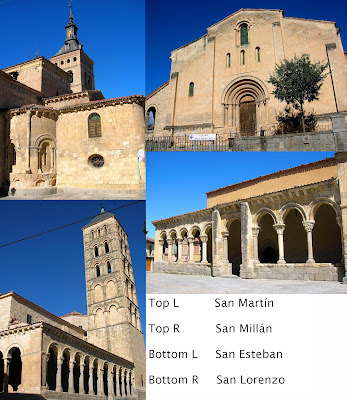 |
| Segovia |
There is also the Alcazar. If you visit this enchanting fortress, you might well think it looks familiar - particularly if you have visited a famous American holiday destination - the Alcazar in Segovia was allegedly the inspiration for Walt Disney's Sleeping Beauty Castle! The castle has another link with America - it was here that Queen Isabella gave Columbus financial backing for his trip to discover the New World. The castle sits high on a ledge overlooking the city. The Moors had originally built it in the 12th century and it became a favourite residence of the kings of Castile. The Catholic Isabella was proclaimed Queen of Castile here in 1474. Over the centuries, the castle was enlarged and embellished - the 'Disney-like' conical spires were added during the reign of King Philip II in the 16th century. Today, it is a museum and, if you get bored of looking at medieval weapons and armour, you could climb to the top of a tower. The 152 steps are worth climbing for the views!
 |
| Alcazar Segovia |
Romantics may prefer the castle but the Aquaduct is probably the most famous monument in Segovia. Known locally as El Puente, it stands at the entrance to the historic section of the city and is a masterpiece of Roman engineering. It was built at the end of the 1st century AD and, nearly 2000 years later, it is still well preserved despite the fact that no mortar was used - the granite blocks are held together by nothing other than their own weight! The aquaduct is colossal - 20,400 granite blocks were used to build the main part of the structure, which has 166 arches.
 |
| Aqueduct Segovia |
The aqueduct may be the symbol of Segovia but the Cathedral is probably the most important building in the city. It was begun in 1525, during the reign of Carlos V and is widely considered to be Europe's last great Gothic cathedral.
 |
| Cathedral Segovia |
There are a number of important religious buildings in the city and many are Romanesque - in fact, Segovia has one of the largest concentrations of Romanesque churches in all of Europe, most dating back to the 11th century. The more notable ones are those of San Lorenzo, San Martín, San Millán, La Trinidad and San Esteban. All of the aforementioned churches and many more besides are within the old city walls. One church situated outside of the old town that is worthy of mention is the Church of Vera Cruz. Founded by the Knights Templar it is unusual in that it is dodecahedral - the building has twelve faces making it appear almost circular!
 |
| some churches in Segovia |
There are many other fine monuments in Segovia including important medieval and Renaissance buildings, such as the 15th-century Corn exchange and the 14th-century Tower of los Lozoya. There are magisterial houses and beautiful palaces befitting a royal city.
NB. all of the above images have been declared public domain - special thanks to Zarateman who donated a number of the images including the churches.
NB. all of the above images have been declared public domain - special thanks to Zarateman who donated a number of the images including the churches.
more blogs by Robert Bovington...
"Photographs of | |
"postcards from | |
"you couldn't make it up!" | |
"a grumpy old man in | |
"bits and bobs" | |
"Spanish Expressions" | |
"Spanish Art" | |
"Books About |
No comments:
Post a Comment